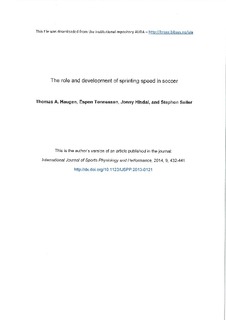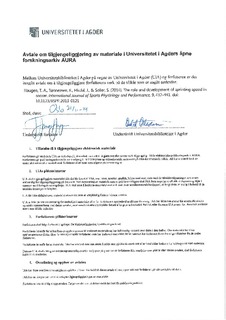| dc.contributor.author | Haugen, Thomas A. | |
| dc.contributor.author | Tønnessen, Espen | |
| dc.contributor.author | Hisdal, Jonny | |
| dc.contributor.author | Seiler, Stephen | |
| dc.date.accessioned | 2014-11-20T10:06:18Z | |
| dc.date.available | 2014-11-20T10:06:18Z | |
| dc.date.issued | 2014 | |
| dc.identifier.citation | Haugen, T. A., Tønnessen, E., Hisdal, J., & Seiler, S. (2014). The role and development of sprinting speed in soccer. International Journal of Sports Physiology and Performance, 9, 432-441. doi: 10.1123/IJSPP.2013-0121 | nb_NO |
| dc.identifier.issn | 1555-0265 | |
| dc.identifier.uri | http://hdl.handle.net/11250/226198 | |
| dc.description | Author's version of an article in the journal: International Journal of Sports Physiology and Performance. Also available from the publisher at: http://dx.doi.org/10.1123/IJSPP.2013-0121 | nb_NO |
| dc.description.abstract | The overall objective of this review was to investigate the role and development of sprinting speed in soccer. Time–motion analyses show that short sprints occur frequently during soccer games. Straight sprinting is the most frequent action before goals, both for the scoring and assisting player. Straight-line sprinting velocity (both acceleration and maximal sprinting speed), certain agility skills, and repeated-sprint ability are shown to distinguish groups from different performance levels. Professional players have become faster over time, indicating that sprinting skills are becoming more and more important in modern soccer. In research literature, the majority of soccer-related training interventions have provided positive effects on sprinting capabilities, leading to the assumption that all kinds of training can be performed with success. However, most successful intervention studies are time consuming and challenging to incorporate into the overall soccer training program. Even though the principle of specificity is clearly present, several questions remain regarding the optimal training methods within the larger context of the team-sport setting. Considering time-efficiency effects, soccer players may benefit more by performing sprint-training regimens similar to the progression model used in strength training and by world-leading athletics practitioners, compared with the majority of guidelines that traditionally have been presented in research literature. | nb_NO |
| dc.language.iso | eng | nb_NO |
| dc.publisher | Human Kinetics | nb_NO |
| dc.subject | football | nb_NO |
| dc.subject | running velocity | nb_NO |
| dc.subject | sprint training | nb_NO |
| dc.subject | physical demands | nb_NO |
| dc.title | The role and development of sprinting speed in soccer | nb_NO |
| dc.type | Peer reviewed | nb_NO |
| dc.type | Journal article | |
| dc.subject.nsi | VDP::Medical disciplines: 700::Sports medicine: 850 | nb_NO |
| dc.source.pagenumber | 432-441 | nb_NO |
| dc.source.volume | 9 | nb_NO |
| dc.source.journal | International Journal of Sports Physiology and Performance | nb_NO |
| dc.identifier.doi | 10.1123/IJSPP.2013-0121 | |

